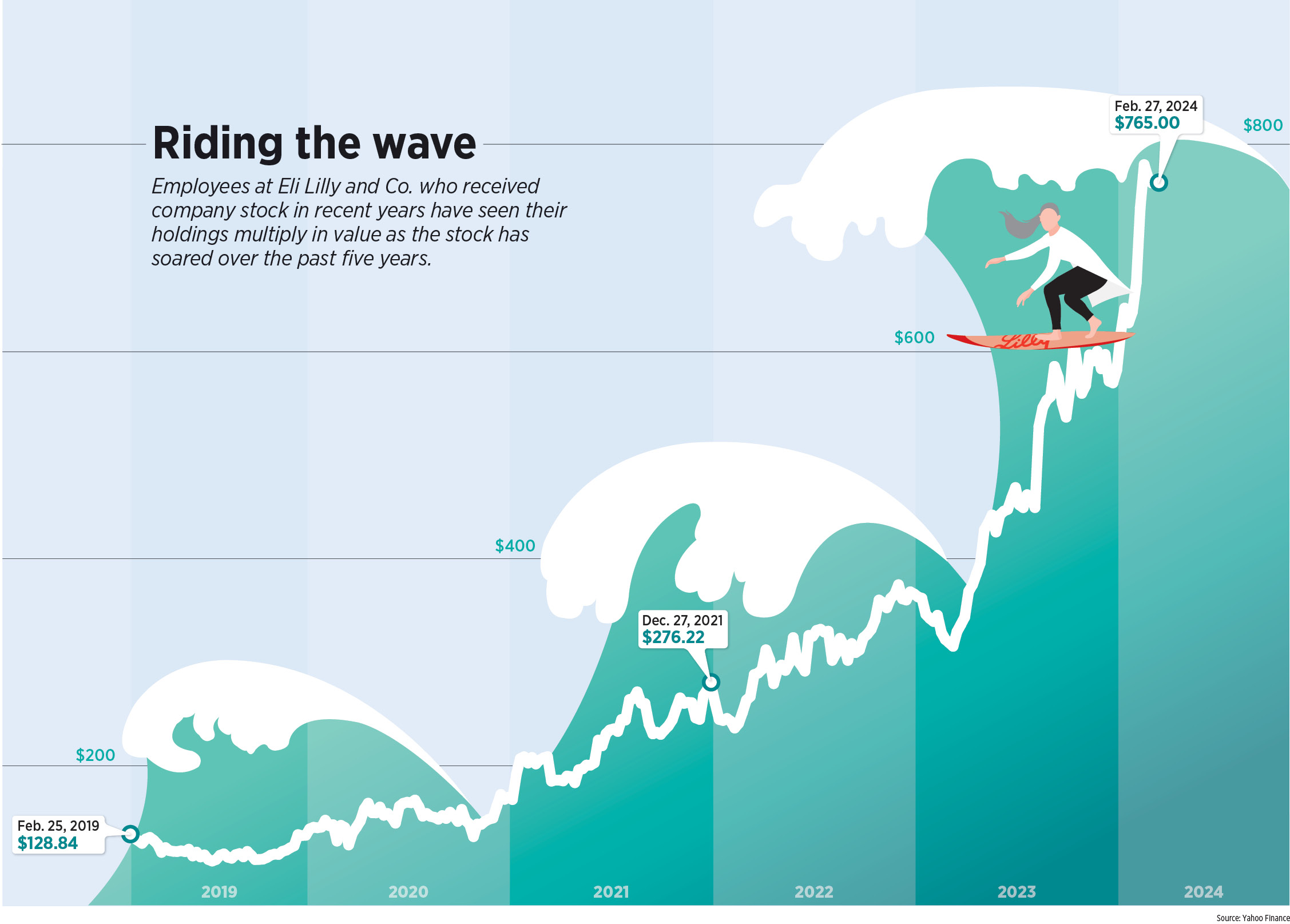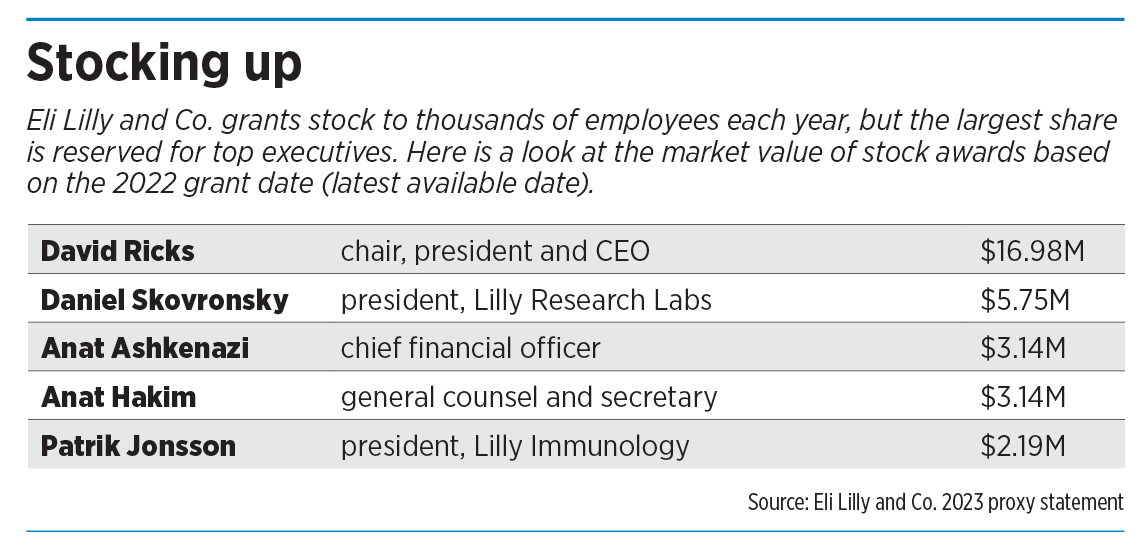Subscriber Benefit
As a subscriber you can listen to articles at work, in the car, or while you work out. Subscribe NowIt wasn’t that long ago that Eli Lilly and Co. employees visited their financial advisers wearing long faces.
Many were getting company stock in addition to a salary, but the shares were not increasing in value. For nearly two decades after a federal judge stripped the Indianapolis-based company’s best-selling drug, the antidepressant Prozac, of its patent protection in 2000, the stock remained basically flat.

“After that Prozac fiasco, we had a 15-year period where the stock didn’t do anything,” said Chris Baker, a certified financial planner and co-owner of Oaktree Financial Advisors in Carmel, whose clients include hundreds of Lilly workers and retirees.
But lately, when Baker talks to clients, he senses a whole new day. In the past five years, Lilly stock has climbed 508%, including a boost of 134% in the past 52 weeks, setting new records almost every week, due to investor eagerness over the company’s new drugs for obesity and diabetes, two health conditions that plague America, along with other drugs in the pipeline.
“People are excited,” Baker said. “It’s extra money.”
Lilly stock hit $781 in afternoon trading Friday, up $25, after one analyst, Geoff Meacham at Bank of America, said shares could hit $1,000 within a year.
Stock grants, or equity compensation, are a type of non-cash pay a company offers employees to take partial ownership of the firm. Employees are free to hold on to the shares, and hope they continue rising, or to sell them. Lilly’s most common form of equity award is known as restricted stock units, which typically vest in stages over three years, meaning employees must stay with the company several years to receive the stock.
Nearly 90% of Lilly’s 43,000 employees hold at least a few shares of stock granted by the company in the form of restricted stock units, which usually take three years to vest. Lilly typically gives more stock to higher-level employees.
That adds up to millions of dollars in extra wealth for Indianapolis as Lilly’s stock climbs ever higher, and employees are getting a share of the riches. More than 11,000 employees—or more than one-quarter of the company’s workforce—live in Indiana.
The drugmaker is spending hundreds of millions of dollars a year to issue stock to employees. In 2023, Lilly recorded $628.5 million in stock-based compensation expense in 2023, up 69% from a year earlier.

Lilly’s top executives get shares each year worth millions of dollars in the form of performance awards, shareholder value awards and relative value awards. In 2022, CEO David Ricks received stock awards worth $16.9 million, making up the bulk of his $21.4 million compensation package. That was his highest award so far in that category and around $2 million more than his equity pay in 2021, according to Fierce Pharma, an industry news site. (Lilly will file its 2023 compensation figures later this month.)
“Generally, as an individual’s job level increases, so does their equity participation,” the company said in a statement to IBJ. “In addition, Lilly periodically provides equity as a special grant to unite employees globally as company owners.”
Retention tool
Across America, millions of workers own shares in the companies they work for. As of April 2022, about 43% of public companies and 35% of private companies provide equity compensation benefits to their employees, according to Morgan Stanley’s State of Equity Plan Management Report.
Some of the largest U.S. companies are digging deep to hand out bigger and better awards. In 2021, Apple said it would hand out stock bonuses of $180,000 to retain top engineers. Amazon said it would start making stock grants to employees when they are promoted, rather than waiting until the next annual grant cycle.

A key reason for handing out the stock grants: retaining top talent, especially in a tight labor market, said Thomas Kopelman, a financial adviser and co-founder of AllStreet Wealth in Indianapolis.
“When you have $50,000 to $100,000, if not more, in restricted stock units vesting, you’re probably not going to leave and take another job,” he said. “It’s always hard to leave when you have a big amount of compensation coming.”
Consumer websites agree that giving equity to employees can be a good way to retain talent and to include them in company ownership, according to NerdWallet, a personal finance company based in San Francisco.
“Since the potential for a hefty payout is appealing, equity compensation benefits are often used to attract and retain top talent,” the company’s website says. “However, you’ll generally have to meet certain conditions to earn your reward, such as abiding by a vesting schedule. This means you’ll need to stay employed with the company for a set time before your ownership rights commence. Also, there is always the possibility that the windfall you’re hoping for never comes to fruition.”
At Lilly, the stock has mostly been headed in one direction, up, for more than three years, pushing the market value of the company to $730 billion in recent days.
And lately, some outside financial experts are wondering whether Lilly could break through the $1 trillion level.
Already, Lilly, which trades under the ticket LLY, is the most valuable pharmaceutical health care company in the world, surpassing larger companies such as New York-based Pfizer and New Jersey-based Johnson & Johnson. But now Lilly stock is pushing a realm populated by only a handful of publicly traded companies, including Microsoft, Apple, Amazon, Meta and Alphabet.
“Could LLY be the first $1 trillion biopharma stock?” Morgan Stanley analyst Terence Flynn wrote in a report last month. “We continue to see a path for further upside.”
Years ago, Lilly used to provide its 401(k) matches in the form of company shares, a process that tended to load up employees’ retirement nest eggs in Lilly stock, for better or worse. Today, the company match goes to wherever the employee directs it—for example, into index funds, Baker said.
‘A decent amount’
For the wide swath of the Lilly workforce, getting the grants does not depend on each employee’s hitting a specific metric, a process that could be uneven and difficult to measure given the wide number of job categories, from scientist and physician to marketing manager or sales representative.
Higher up the food chain, however, managers must help the company hit specific targets to receive equity that could be worth six figures or more.
For these higher categories, payouts are based on the company’s hitting metrics such as growth in earnings per share over a two-year performance period. One category, called shareholder value awards, is earned based on Lilly’s share-price performance.
IBJ attempted to interview Lilly employees near the campus about stock ownership, but they said they are not permitted to talk to the media without company approval.
Some financial advisers who work with Lilly employees, however, say stock grants can be a nice windfall, especially for people in middle management or higher who have been with the company for years. While it’s not making millionaires out of everyday workers, it still amounts to much more than just walking-around money.
One senior scientist at Lilly who is close to retirement made nearly $165,000 after taxes last year in stock grants, said Baker of Oaktree Financial.
A junior worker got 103 shares of Lilly stock last year, which today have a market value of about $79,000 before taxes, he added. The vast majority of Lilly employees he advises receive 15 to 75 restricted stock units a year.
“It’s still a decent amount, but not millions and millions,” he said.
As soon as they vest, “they are no longer restricted and are treated exactly the same as if you had bought Eli Lilly’s shares on the open market,” Kopelman told clients in a note.
When the shares vest, the value of the stock is taxed as ordinary income, and some financial planners advise employees to sell a fraction of the shares to pay the taxes.
The question for employees, looking ahead, is when and whether to sell those shares.
“When the stock was underperforming, people were selling,” Baker said. “Now that it’s outperforming, a lot of them are saying, ‘I’m gonna hold those shares.’”•
Please enable JavaScript to view this content.



134 P/E and 0.66% sound as healthy as drugs to fight poor diet and exercise.
In separate news, consumers struggle to pay drug costs…
Too bad you don’t understand what is going on. Unrelated.
Don’t understand what? Charging a $1000 a month for something that costs less than $10 to manufacture? No, I think we all get it.